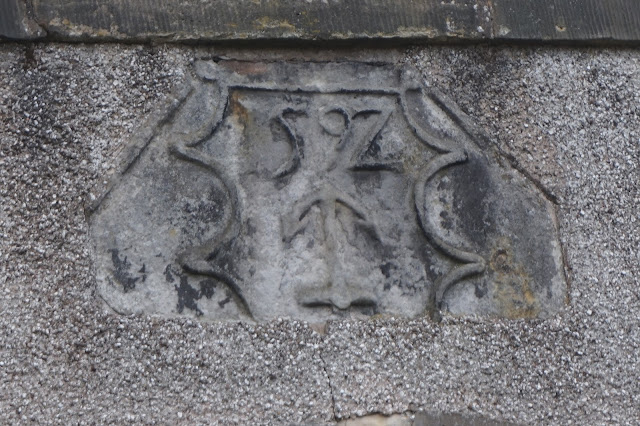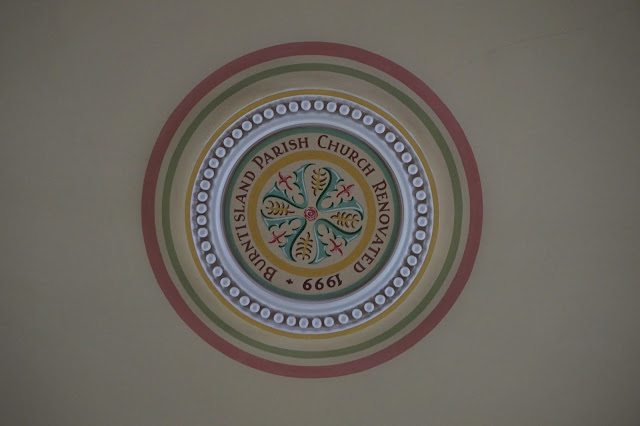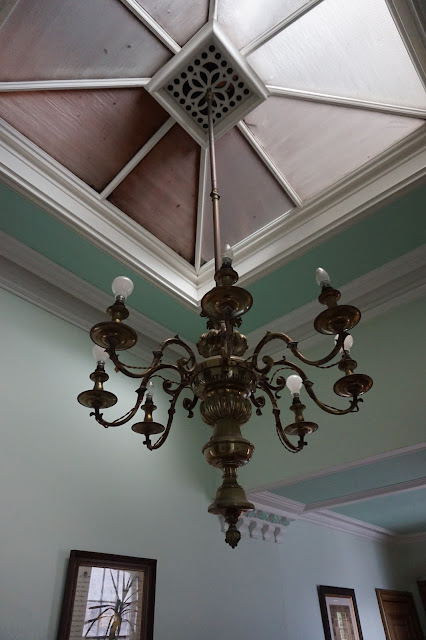In March of 2016 I paid my first visit to Burntisland, Scotland, home of Mary Fairfax Somerville (1780-1872). This was part of my initial sabbatical, and one of my posts about that is at this link. Since that time I have read her memoirs and have found her life story compelling and relatable. The picture above is of her home, and the picture below is of her church (or kirk) through the gate. Because the religious life of her childhood impacted her strongly and because it reminds me a bit of my own strict Calvinist upbringing, I made it a goal on this trip to get inside her childhood church: Burntisland Parish Church, which was built in 1592. It took some doing, but eventually connections were made, and a mid-week visit was possible. As it turned out I had basically three guides with me while there, so it was a VERY informative time!
Burntisland is right on the Firth of Forth, so it has always had a close relationship with sailing and shipbuilding and other seafaring ventures, hence the ship on the gates of the kirk.
Above the door is 1592, the date the church was built. I might not have noticed the upside-down anchor if it hadn't been pointed out to me. Hebrews 6:19 calls hope the anchor of the soul, so an anchor is a Christian symbol of hope. The fact that this anchor is upside-down represents that the place of our hope is in Heaven.
I had known from Mary's memoirs about the paintings on the panels in the church. These have recently been restored, but they remain the dates and images she would have seen in her time.This church is one of the first built after the Scottish Reformation. It is in the shape of a square, which is unique in Scotland. In the video below this picture you'll hear the man who was telling Toby and me about the church state that there is also one in the Netherlands and perhaps one in France but that it is pretty rare in general. The idea is of a family sitting around a table listening to the word of the Lord.
Below I'm looking from the wall of the church toward the Fairfax pew. I caught Toby and my other guide unaware, but I was taking video and pictures so quickly while trying to take in all that was said . . . we really didn't have a lot of time here, but there was much to take in!
Renovation work was done in the 1990s, which would coincide with the 400th anniversary of the church. This included painting of the ceiling, which was done by the painter Michelangelo-style -- lying on his back. When he finished, the roof ended up getting damaged somehow, and he had to start over!
Looking up, I found it hard to believe that this is a flat painting. The circles surrounding the center seem to me to pop out as spheres.
Another view of me - but only because it gives a different view of the balcony.
And here is probably the most fun selfie I have ever taken - in the organists mirror.
We spent time in the kirkyard as well as in the kirk itself.
Around on the back corner is a second entrance that is specifically for sailors. Apparently they were promised this when the church was first built, but it was put in somewhat later.
Here too there is the upside-down anchor, reminding us that our hope is in Heaven.
I keep referring to Mary as Mary Fairfax Somerville, because she was part of the Fairfax family of Burntisland. Her father, Sir William Fairfax was a vice admiral in the navy and is buried here behind the kirk, as is her mother Margaret Charters and her grandfather William Charters.
The tombstone pictured below contains a lot of iconography including a skull on the top right, scales on the left, a backwards 4 with masonic symbols on the right, and a memento mori on the bottom, along with crossbones and an hourglass (tempus fugit).
The story of George Arnot, tombstone pictured below, is quite an interesting one.
Apparently George was a bit odd in a way that 19th century townsfolk wouldn't have had a name for. He was like the Forrest Gump of his day. Notice that on his stone he is pictured barefooted; that is because he went barefoot year-round, no matter the weather. He was in some ways cognitively slow, and yet he had a prodigious memory. For example, if someone was housebound and had to miss church, he would go to their house and share the sermon with them word-for-word and also the hymns! Just by hearing the sermon he immediately had it memorized. He worked as some sort of a laborer, and was well-loved but probably a bit ostracized as well. As a joke, someone put snuff in his beer one night, and it killed him. The townspeople felt terrible and all chipped in for the tombstone for him, at the bottom of which are the lines:
After finishing our brief but full time at the kirk and kirkyard, we headed back to the Burgh Cambers where the Heritage Trust Museum is. We were treated to a PowerPoint presentation on the life of Mary Somerville by Ian and then given a tour of the Burgh Chambers.
Here is the council chamber. In the center of the opposite wall you can see the picture of the magistrate's pew in the kirk that I uploaded earlier in this post.
Above the staircase is this chandelier that has been here long enough to have see the use of candles, gas, and electricity.
Below is the courtroom.
At the back of the courtroom is a painting titled The Bridge of Life. It shows people at all stages of life as they set out for eternity. There's a lot of interesting symbolism here, and it seems quite apropos for a courtroom.
Back downstairs is a wonderful museum with quite a variety of things. One thing that interested me most were the panels discussing the history of crossing the firth. Mary's family had to board a ferry in order to cross from Burntisland to Edinburgh, which is something that Mary's mother was very fearful of but which they had to do. The family owned a home in Edinburgh as well as in Burntisland, and part of Mary's education took place in Edinburgh (which could be the topic for a whole other post).
That was a very full morning and early afternoon, but the day didn't stop there -- it continued with a trip to the airport to figure out the COVID testing situation, then Toby getting a puncture in his tyre fixed, him dropping me off at the edge of town (which was fine!) and me wandering through Dean Village Cemetery on my way to the modern art galleries and then making my way back to Stockbridge through Dean Village and along the Water of Leith Walkway with a lengthy stop at my favorite place along the water. I think I did some grocery shopping too and then also went back out to look for the Fairfax family home in Edinburgh, which I did find. Ian's PowerPoint included the address, but Toby had made the comment that the street may have been renumbered since then. I knew there was supposed to be a plaque next to the door, and when I went to the address I'd been given I didn't see the plaque, so I walked the length of the whole street and finally found it -- one of many treasure hunts! I love finding treasure!






















































No comments:
Post a Comment